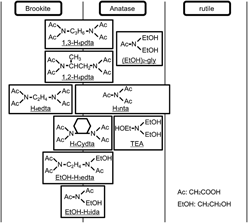Crossref Citations
This article has been cited by the following publications. This list is generated based on data provided by
Crossref.
Kobayashi, Makoto
Osada, Minoru
Kato, Hideki
and
Kakihana, Masato
2015.
Design of crystal structures, morphologies and functionalities of titanium oxide using water-soluble complexes and molecular control agents.
Polymer Journal,
Vol. 47,
Issue. 2,
p.
78.
KOBAYASHI, Makoto
2016.
Synthesis and development of titania with controlled structures.
Journal of the Ceramic Society of Japan,
Vol. 124,
Issue. 9,
p.
863.
Truong, Quang Duc
Dien, Luong Xuan
Vo, Dai-Viet N.
and
Le, Thanh Son
2017.
Controlled synthesis of titania using water-soluble titanium complexes: A review.
Journal of Solid State Chemistry,
Vol. 251,
Issue. ,
p.
143.
Hoffmann, Rudolf C.
Sanctis, Shawn
and
Schneider, Jörg J.
2017.
Molecular Precursors for ZnO Nanoparticles: Field-Assisted Synthesis, Electrophoretic Deposition, and Field-Effect Transistor Device Performance.
Inorganic Chemistry,
Vol. 56,
Issue. 13,
p.
7550.
Gao, Mengyu
Ma, Yulong
Qi, Lina
Liang, Jianjun
Si, Yang
and
Zhang, Qinghong
2018.
Anatase TiO2 nanocrystals via dihydroxy bis (ammonium lactato) titanium (IV) acidic hydrolysis and its performance in dye-sensitized solar cells.
Journal of Porous Materials,
Vol. 25,
Issue. 5,
p.
1499.
Hezam, Mahmoud
Qaid, Saif M. H.
Bedja, Idriss M.
Alharbi, Fahhad
Nazeeruddin, Mohammad Khaja
and
Aldwayyan, Abdullah
2019.
Synthesis of Pure Brookite Nanorods in a Nonaqueous Growth Environment.
Crystals,
Vol. 9,
Issue. 11,
p.
562.
Strapasson, Guilherme B.
Scheffer, Francine R.
Cendron, Suelen W.
Silva, Felipe de C.
Lazzari, Nicole H.
Azambuja, Caio
Peyrot, Andressa
and
Weibel, Daniel E.
2020.
Visible light sensitization of TiO2/Ag/N nanostructures synthesized by microwave irradiation for oxidative degradation of organic dyes.
SN Applied Sciences,
Vol. 2,
Issue. 4,
Sarigul, Gamze
Gómez-Palos, Isabel
Linares, Noemi
García-Martínez, Javier
Costa, Rubén D.
and
Serrano, Elena
2020.
The use of N^N ligands as an alternative strategy for the sol–gel synthesis of visible-light activated titanias.
Journal of Materials Chemistry C,
Vol. 8,
Issue. 36,
p.
12495.
Kajiwara, Shohei
Itatani, Kiyoshi
Kuwahara, Hideki
Yokoi, Taishi
Sasaki, Tetsuo
and
Kuroe, Haruhiko
2023.
Anatase/Rutile Phase Control of Titanium Oxide Nanoparticles Synthesized from Potassium Titanium Oxalate by Homogeneous Precipitation and Hydrothermal Methods.
Nano Hybrids and Composites,
Vol. 40,
Issue. ,
p.
7.
Cao, Tihao
Dong, Weixia
Liang, Yunzi
Bao, Qifu
Xu, Chenlang
Bai, Mingmin
Luo, Ting
and
Gu, Xingyong
2023.
A simple solvothermal preparation of Mg-doped anatase TiO2 and its self-cleaning application.
Solar Energy,
Vol. 249,
Issue. ,
p.
12.
Qaid, Saif M. H.
Ghaithan, Hamid M.
Bawazir, Huda S.
Bin Ajaj, Abrar F.
AlHarbi, Khulod K.
and
Aldwayyan, Abdullah S.
2023.
Successful Growth of TiO2 Nanocrystals with {001} Facets for Solar Cells.
Nanomaterials,
Vol. 13,
Issue. 5,
p.
928.
Migaszewski, Zdzisław M.
and
Gałuszka, Agnieszka
2023.
Hydrothermal TiO2 polymorphs in a pyrite stratiform deposit: Lessons from a mineralogical and geochemical multiproxy record.
Chemical Geology,
Vol. 632,
Issue. ,
p.
121551.





